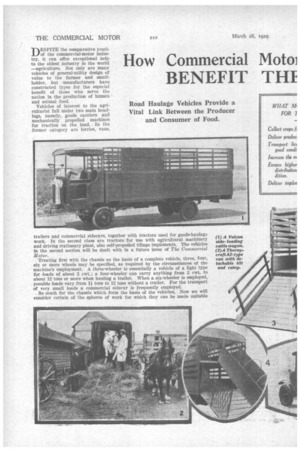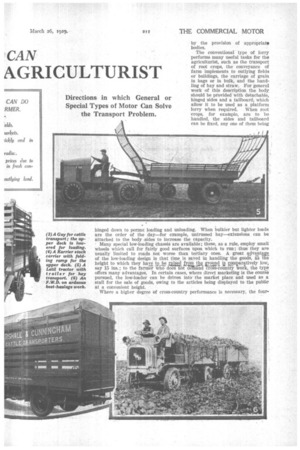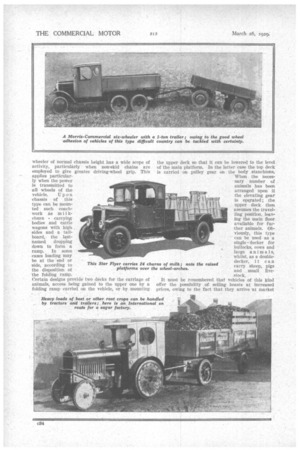How Commercial Motoi
Page 62

Page 63

Page 64

Page 65

If you've noticed an error in this article please click here to report it so we can fix it.
CAN
BENEFIT TH1 AGRICULTURIST
TAESPITE the comparative youth
of the commercial-motor industry, it can offer exceptional help to the oldest industry in the world —agriculture. Not only are many vehicles of general-utility design of value to the farmer and smallholder, but -manufacturers have constructed types for the especial benefit of those who serve the nation in the production of human and animal food.
Vehicles of interest to the agriculturist fall under two main headings, namely, goods carriers and mechanically propelled machines for traction on the land. In the former category are lorries, vans, trailers and commercial sidecars, together with tractors used for goods-haulage work. In the second class are tractors for use with agricultural machinery and driving stationary plant, also self-propelled tillage implements. The vehicles in the second section will be dealt with in a future issue of The Commercial Motor.
Treating first with the chassis as the basis of a complete vehicle, three, four, six or more wheels may be specified, as required by the circumstances of the machine's employment. A three-wheeler is essentially a vehicle of a light type for loads of about 2 cwt.; a four-wheeler can carry anything from 2 cwt. to about 12 tons or more when hauling a trailer. When a six-wheeler is employed, possible loads vary from 1i tons to 12 tons without a trailer. For the transport of very small loads a commercial sidecar is frequently employed.
So much for the chassis which form the basis of the vehicles, Now we will consider certain of the spheres of work for which they can be made suitable by the provision of appropriate bodies.
The conventional type of lorry performs many useful tasks for the agriculturist, such as the transport of root crops, the conveyance of farm implements to outlying fields or buildings, the carriage of grain in bags or in bulk, and the handling of hay and straw. For general work of this description the body. should be provided with detachable, hinged sides and a tailboard, which allow it to be used as a platform lorry when required. When root crops, for example, are to be handled, the sides and tailboard can be fixed, any one of them being
hinged down to permit loading and unloading. When bulkier but lighter loads are the order of the day—for example, untrussed hay—extensions can be attached to the body sides to increase the capacity.
Many special low-loading cbassiS are available; these, as a rule, employ small wheels whidi call for fairly good surfaces upon which to run; thus they are usually limited to roads not worse than tertiary ones. A great advantage
of the low-loading design is that time is saved in handling the goods, the height to which they have to be ,Lakeed kora tht matad. torinparatively low, say 15 ins.; to the farmer who does not Teit and cross-country work, the type offers many advantages. In certain cases, where .direct marketing is the coutce pursued, the low-loader can be driven into the market place and used as a stall for the sale of goods, owing to the articles being displayed to the public at a convenient height.
Where a higher degree of cross-country performance is necessary, the four
wheeler of normal chassis height has a wide scope of activity, particularly when non-skid chains are employed to give greater driving-wheel grip. This applies particularly when the power is transmitted to all wheels of the
vehicle. Upon chassis of this type can be mounted such coachwork as milkchurn carrying bodies and cattie wagons with high sides and a tailboard, the ' . lastnamed dropping down to form a ramp. in some cases loading may be at the end or -side, according to the disposition of the folding ramp. Certain designs provide two decks for the carriage of animals, access being gained to the upper one by a folding ramp carried on the vehicle, or by mounting
This Star Flyer carries platforms 24 chez over t
the upper deck so that it can be lowered to the level of the main platform. In the latter case the top deck is carried on pulley gear on the body stanchions. When the necessary number of animals has been arranged upon it the elevating gear is operated; the upper deck then assumes the travelling position, leaving the main floor available for further animals. Obviously, this type can be used as a single decker for bullocks, cows and large an i
whilst, as a doubledecker, it can carry sheep, pigs and small live stock.
It must be remembered that vehicles of this kind offer the possibility, of selling beasts at increased prices, owing to the Tact that they arrive at market in a clean condition, not fatigued bya previous journey, as part of flocks or herds; markets can be sought farther afield than would be the case if the animals were driven on the road. The speed of the motor also offers the advantage that stock can be delivered to distant markets more rapidly than is possible when railway transport is used.
If a lorry body is to be used for animal transport as well as for other loads, it Is an advantage to have two tailboards, one being of the ordinary type and the other of the ramp pattern, the two being interchangeable. When an ordinary • 'low-sided lorry body is employed for carrying sheep or pigs, it is essential that some protection in the form of a net be fixed over the sides to prevent • excited animals jumping overheard. 'Low-loading Machines possess obvious advantages for handling cattle, 'owing to the gradual slope up -which the animals must walk.
An allied task is the transport of horses of varrous kinds, such as valuable breeding stock, thoroughbreds, or draft horses, where rapid transport coupled with the minimum of risk of injury is essential. Special vehicles of the end-loadingor side-loading type are employed for this work.
For more arduous conditions of agricultural transport service, in the form of collecting beet and other root crops direct from the fields, the six-wheeler shows up to a marked extent, as it can traverse surfaces which would stall the majority of other types. When a detachable track-band over the rear bogie wheels is used, still more difficult terrain can be mastered, and -agriculturists should not overlook the £120 War Office subsidy which is offered for suitable machines.
Duringrecent years a large number of farmers and 'smallholders has paid increasing attention to beet crops for sugar production, and the collection of the roots from the fields is work of growing importance.
The tractor, with suitable trailers, can also be used for this work. As-the crop usually has to be transt ported in October or November, when ether tasks of considerable urgency are on hand, the speed and large capacity of motor vehicles offer marked advantages in comparison with horsed transport In our issue dated January 22nd we gave details of a system of beet transport by means of, lorries loaded by mobile cranes with scoops, thus obviating the man-handling of beet in bulk.
When conventional fouror six-wheelers are employed for cross-country service, supplementary gears can often be fitted, thus giving six or eight forward speeds, the lowest of which is easily capable of enabling the vehicle to traverse arable land beyond the scope of the normal first speed ratio.
When a motor vehicle is used for transport work of any kind, it is of the utmost importance that US time should be employed, so far as is possible, in travelling. Terminal delays can be greatly minimized by the employment of winches and other aids for loading, also by tipping gear hit the discharge of burdens from the vehicle.
• Farmers and smallholders can also be served by motorcars which permit passenger or goods transport by the employment of -convertible bodies; sidecars with interchangeable or convertible bodies offer the same possibilities. • • It must not be forgotten that recent legislation has done much to aid the farmer and smallholder to make the commercial motor a paying proposition, in that tar reductions have been arranged for the heavier types used solely for the conveyance of produce of, and articles' for, tile land occupied by the party registering the vehicle. The same applies to tractors for road work when used for hauling the produce of, or articles required for, agricultural land.




























































































































